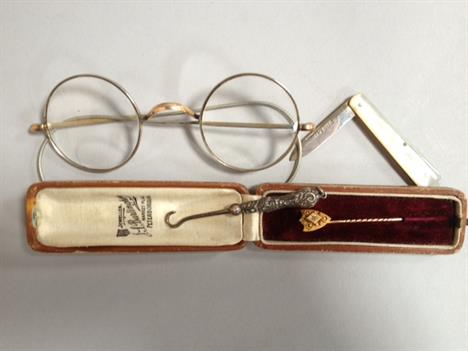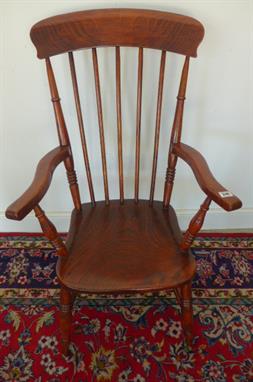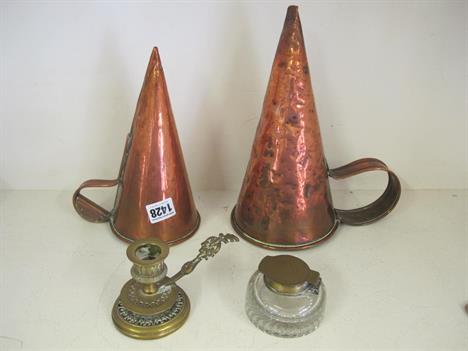We found 133746 price guide item(s) matching your search
Receive email alerts when new lots matching "stick" come up for sale.
Receive email alerts when new lots matching "stick" come up for sale.
There are 133746 lots that match your search criteria. Subscribe now to get instant access to the full price guide service.
Click here to subscribe- List
- Grid
-
133746 item(s)/page
RODS & HOLDALL (4): Bruce & Walker CTM14 hollow glass float rod, burgundy whipped high bells guides, cork handle, red agate butt/tip rings, in fitted blue cloth bag, an Edgar Sealey Contestant 13’ 3 piece staggered ferrule, hollow glass float rod, red agate butt/tip guides, cork handle with alloy fittings, good, in Sealey bag, a Shakespeare 1082 hollow glass junior float rod with snap reel fittings, all contained in early Efgeeco canvas/leather rod holdall, 58” long with 2 front pockets and rear bank stick pocket, brass zips throughout, shoulder sling and carry handle.
A Scarce Second War 1944 `Parachute Jump Instructor`s` A.F.M. Group of Six to `Ringway Character`, Warrant Officer W.T. Aldridge, Royal Air Force, Who With Over 150 Descents and 300 Flying Hours Was Prominent in The Training of The 6th Airborne Division for D-Day; He Flew With The 6th Airborne as a Despatcher For the Invasion of Normandy a) Air Force Medal, G.VI.R. (524775 F/Sgt. W.T. Aldridge. R.A.F.) b) 1939-1945 Star c) France and Germany Star d) Defence and War Medals e) Royal Air Force Long Service & G.C., E.II.R. (W./O. W.T. Aldridge. (524776) R.A.F.), generally good very fine, mounted as originally worn, with the following related documentation: - Congratulatory Letter to the recipient from Air Marshal Sir Roderic Hill, K.C.B., M.C., A.F.C., on the occasion of the award of the A.F.M., dated 27.9.1944 - Letter to the same effect from Major W.H. Smith, `D` Company 34th (Bilston) Battalion, South Staffordshire Home Guard - With a photocopy of recipient`s R.A.F. Observer`s and Air Gunner`s Flying Log Book (5.7.1942-10.10.1949) (lot) A.F.M. London Gazette 1.9.1944 524776 Flight Sergeant William Thomas Aldridge, Royal Air Force, Parachute Training School, Royal Air Station, Ringway (No. of descents 70) The Recommendation states: `Flight Sergeant Aldridge has served as an instructor with the Parachute Training School for two years and proved himself to be a first class teacher who instils great confidence into his pupils. Prior to the invasion of Normandy, this airman was attached to the 6th Airborne Division to assist in the final training of the airborne troops. He frequently accompanied them on their exercises and, during the invasion, flew as a despatcher with the airborne troops. His courage and efficiency have contributed much to the building up of confidence and morale among airborne troops.` 524776 Warrant Officer William Thomas Aldridge, A.F.M., a native of Wolverhampton; joined the Royal Air Force for service during the Second War, and commenced training as a Parachute Jump Instructor in `B` Squadron, Parachute Training Squadron, Ringway, Manchester; he made his first parachute descent, 5.7.1942; qualified as Flight Sergeant, Parachute Jump Instructor, 27.7.1942; appointed to the P.J.I. Staff at Ringway, 29.7.1942, and over the coming months made demonstration, training, container and night descents, air experience flights and despatched trainee parachutists from balloons, Whitley and Harrow aircraft at 500-800 feet; he jumped with both `old` and `new` parachute packs from Whitley floor and rear-gunner exits; in late 1942 he trained Belgian, Czech and Polish paratroopers at Ringway; by the end of that year he had completed 21 descents and over 36 flying hours; throughout 1943 he continued instructing troops, including No. 12 Commando, Combined Ops, Canadians, Norwegians and Free French soldiers; on 10.2.1943 he made an experimental jump in a 20 man stick from a US Army Air Force Douglas Dakota, and on 3.12.1943 he jumped as 6th man in the first experimental jump with kit-bags; by the end of the year he had completed 62 descents and over 100 flying hours; posted to Bulford in the first week of January 1944 to train parachutists of 6th Airborne Division in preparation for the D-Day Operations; on the 8th-14th January he ran a balloon programme, when the following occurred, `the powerful influence of an experienced and determined instructor is illustrated by a report which I received concerning Flight Sergeant Aldridge. If a man refused to jump or asked to be taken off parachuting during his basic training at Ringway no stigma was attached to him and he was merely sent back to his unit..... Once he had completed his training and accepted the badge and pay of a qualified paratroop it was a different matter and refusal to jump - unless there was a genuine and acceptable excuse - meant a court martial..... I had been asked to send two or three experienced instructors to Bulford to see what they could do with a number of men who had let it be known that they didn`t intend to do any more parachuting. Such gossip did not of itself constitute a refusal to jump, but it was bad for morale and had to be stopped one way or the other. Bulford was the camp occupied by the Airborne Division and a balloon similar to those in use at Ringway had been installed there. Flight Sergeant Aldridge was one of the instructors selected for the duty. He was a sturdy man experienced in obeying orders and equally competent at seeing that orders he gave were acted upon. In due course he was shown a small group of men and told that they were being "difficult" about parachuting. They were already fitted with parachutes, jumping overalls and rubber crash hats, so he wasted no time in getting them into the balloon car, hooking them up and giving the word to the winch operator - "Up 700 - 4 down", which, being interpreted, meant that the balloon was to go up to 700 ft. and that four men would be jumping. Flight Sergeant Aldridge was on his mettle! There was a certain amount of muttering among the men when the balloon started to rise, but as the ground receded and the feeling of security decreased they huddled in the corners of the car and relapsed into silence. At last the winch stopped and, having satisfied himself that everything was in order, Aldridge said in a quiet but very firm voice "Now look here, you fellows, you`ve all been to Ringway and you all know how to jump - so don`t let`s have any damned nonsense. When I say go - I mean Go." A small balloon car, the floor of which is mostly hole, swaying uneasily 700 ft. above the earth, is not a good place to start an argument and numbers one, two and three went out like "good-uns" on the crisp words of command. Number four, however, showed no inclination to take up position and strongly protested that he wasn`t going to jump. Aldridge thought otherwise and as he moved across the car he muttered viciously: "Now then, you blighter, one last chance - are you to jump or aren`t you? Action stations - Go!" and go the man did. Looking over the side at the scrabbling mass of arms and legs, Aldridge fired his parting shot: "That was a ruddy awful exit - you`d better do better next time." A few hours later Flight Sergeant Aldridge was surprised to receive instructions that he was to report to General Gale, the Divisional Commander. After some preliminary talk about parachuting and the good work down by the P.T.S. the General said: "By the way, didn`t you take up some men this morning who were expecting to refuse?" "Yes, sir," answered Aldridge proudly, "but they all jumped - it just depends on how you treat them." "How very true," observed the General with a twinkle in his eye. "It may interest you to know that one of your pupils was an officer of the Provost Marshal`s department who had never previously made a parachute descent and who went up as a witness in case any of the men refused to jump. I gather that he didn`t altogether appreciate the experience." Aldridge`s normal ruddy complexion flushed a few shades darker as he answered: "Well, sir, nobody told me who he was and he looked like a paratroop." "And so he ought to be," said the General greatly amused, "and even if he didn`t like it the men did. The story is all over the camp and doing any amount of good." The period training the 6th Airborne Division was hectic, and drops included ballooons, single up to 250 aircraft drops, using Albemarle, Stirling, Halifax and Dakota aircraft; Aldridge trained and despatched troops from a mulititude of units including from 3rd, 5th, 7th, 8th, 9th, 12th and 13th Battalions Parachute Regiment, 1st Canadian Para Battalion, Independent Para Company, and 224 Para Squadron; on 18.6.1944 he took off from Tarrant Rushton in a Halifax of 644 Squadron. View Terms & Conditions
A single stone poppy jasper ring, an oval high cabochon jasper, rub set to a plain bezel, later mounted to an under bezel and shank, finger size K½ Probably a converted tie pin or stick pin. Original rub setting tested as approximately 9ct gold. Bezel and shank tested as approximately 18ct gold.
-
133746 item(s)/page
















































